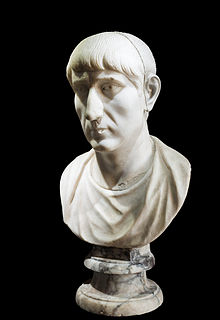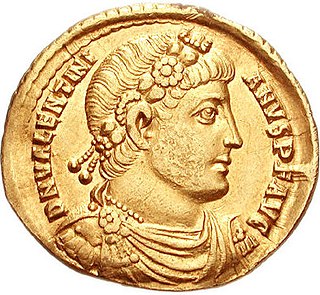Ammianus Marcellinus was a Roman soldier and historian who wrote the penultimate major historical account surviving from antiquity. His work, known as the Res Gestae, chronicled in Latin the history of Rome from the accession of the Emperor Nerva in 96 to the death of Valens at the Battle of Adrianople in 378, although only the sections covering the period 353 to 378 survive.

Flavius Julius Constantius, known as Constantius II, was Roman emperor from 337 to 361. His reign saw constant warfare on the borders against the Sasanian Empire and Germanic peoples, while internally the Roman Empire went through repeated civil wars, court intrigues and usurpations. His religious policies inflamed domestic conflicts that would continue after his death.

Flavius Valens was Roman emperor from 364 to 378. He was the younger brother of the emperor Valentinian I, who gave Valens the eastern half of the Roman Empire to rule. Before 364, Valens had a largely unremarkable military career. In 378, Valens was defeated and killed at the Battle of Adrianople against the invading Goths, which astonished contemporaries and marked the beginning of barbarian encroachment into Roman territory.
The 350s decade ran from January 1, 350, to December 31, 359.

Magnus Maximus was Roman emperor in the western portion of the Empire from 383 to 388. He usurped the throne from emperor Gratian in 383, through negotiation with emperor Theodosius I.

The Battle of Adrianople, sometimes known as the Battle of Hadrianopolis, was fought between an Eastern Roman army led by the Eastern Roman Emperor Valens and Gothic rebels led by Fritigern. The battle took place in the vicinity of Adrianople, in the Roman province of Thracia. It ended with an overwhelming victory for the Goths and the death of Emperor Valens.

Valentinian I, also called by some as Valentinian the Great, was Roman emperor from 364 to 375. Upon becoming emperor he made his brother Valens his co-emperor, giving him rule of the eastern provinces while Valentinian retained the west.
"Count" Flavius Theodosius, also known as Theodosius the Elder, was a senior military officer serving Valentinian I and the western Roman empire during Late Antiquity. Under his command the Roman army defeated numerous threats, incursions, and usurpations. Theodosius was patriarch of the imperial Theodosian dynasty and father of the emperor Theodosius the Great.

The Valentinianicdynasty or Valentinian dynasty was a ruling house of five generation of dynasts, including five Roman emperors during Late Antiquity, lasting nearly a hundred years from the mid fourth to the mid fifth century. They succeeded the Constantinian dynasty and reigned over the Roman Empire from 364 to 392 and from 421 to 455, with an interregnum (392–423), during which the Theodosian dynasty ruled and eventually succeeded them. The Theodosians, who intermarried into the Valentinian house, ruled concurrently in the east after 379.
The Battle of Argentovaria or Battle of Argentaria was fought in May 378 between the Western Roman Empire and the invading army of the Lentienses, a branch of the Alemanni, at Argentovaria. The Alemanni were overwhelmed by the Roman legionaries, though stood their ground bravely. Only 9,000 escaped from the field and Priarius, king of the Lentienses, was slain during the battle. The Lentienses disappear from the historical record following this defeat.
Silvanus was a Roman general of Frankish descent, usurper in Gaul against Emperor Constantius II for 28 days in AD 355.

Between 376 and 382 the Gothic War against the Eastern Roman Empire, and in particular the Battle of Adrianople, is commonly seen as a major turning point in the history of the Roman Empire, the first of a series of events over the next century that would see the collapse of the Western Roman Empire, although its ultimate importance to the Empire's eventual fall is still debated. It was one of the many Gothic Wars with the Roman Empire.
Ursicinus was a Roman senior military officer, holding the rank of Magister Equitum per Orient and even Magister Peditum Praesentalis in the later Roman Empire c. 349–359. He was a citizen of Antioch and was well connected in the Eastern part of the Roman Empire.
Flavius Richomeres or Ricomer was a Frank who lived in the late 4th century. He took service in the Roman army and made a career as comes, magister militum, and consul. He was an uncle of the general Arbogastes. He is possibly to be identified with the Richomeres who married Ascyla, whose son Theodemer later became king of the Franks.
Charito was a Roman Empress, consort of Jovian, Roman Emperor. Some historians doubt whether Charito was granted the title of Augusta as no archaeological evidence as yet confirms it.
Serenianus was an officer of the Roman Empire, involved in the death of Caesar Constantius Gallus and in the usurpation of Procopius.
Flavius Merobaudes was a Roman army officer of Frankish origin.
Traianus was a Roman general under Emperor Valens with whom he died in the battle of Adrianople.
Dagalaifus was a Roman army officer of Germanic descent. A pagan, he served as consul in 366. In the year 361, he was appointed by Emperor Julian as comes domesticorum. He accompanied Julian on his march through Illyricum to quell what remained of the government of Constantius II that year. He led a party into Sirmium that arrested the commander of the resisting army, Lucillianus. In the spring of 363, Dagalaifus was part of Julian’s ultimately-disastrous invasion of Persia. On June 26, while still campaigning, Julian was killed in a skirmish. Dagalaifus, who had been with the rear guard, played an important role in the election of the next emperor. The council of military officers finally agreed on the new comes domesticorum, Jovian, to succeed Julian. Jovian was a Christian whose father Varronianus had himself once served as comes domesticorum.
Nannienus, , was a late Roman military commander in the Western Roman Empire.






